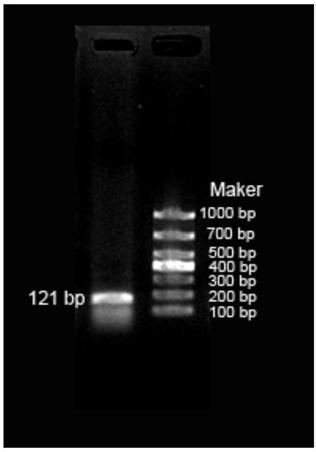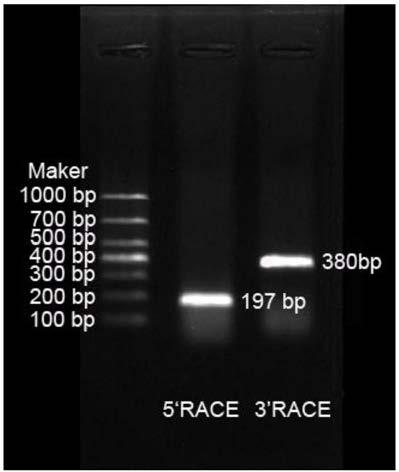Pharaoh cuttlefish neuropeptide sCAP and application thereof
A tabby squid and neuropeptide technology, applied in the field of neuropeptides, can solve the problems of less research on small molecule peptides, and achieve the effects of excellent immunity, reasonable design and convenient operation.
- Summary
- Abstract
- Description
- Claims
- Application Information
AI Technical Summary
Problems solved by technology
Method used
Image
Examples
Embodiment 1
[0036] A tiger squid neuropeptide sCAP, the cDNA sequence of the sCAP gene has a total length of 666bp, including 109bp 5'-UTR, 296bp 3'-UTR and 261bp open reading frame ORF, encoding a total of 86 amino acids with a MW of 9.3kDa , pI8.52. The signal peptide is located between No. 1 and No. 20 amino acids. The protein contains an obvious transmembrane structure. The secondary structure analysis of the protein found that it contains 33.72% extended chains, 66.28% random coil structures, and hydrophilic Analysis showed that the protein contained 28 hydrophilic amino acids and 58 hydrophobic amino acids, which was a hydrophilic protein.
[0037] By qPCR expression analysis, the expression of the SpsCAP gene was clearly detected in the optic lobe of male and female tabby squid, followed by the brain, suggesting that sCAP controls its activity by controlling the nervous system of tabby squid. The trace expression of sCAP in ovary gland and paravertebral gland may be related to the...
Embodiment 2
[0231] Construction and identification of recombinant expression vectors:
[0232] Construction and identification of recombinant plasmids: According to the cDNA sequence of tiger squid neuropeptide sCAP, a pair of specific primers P1 and P2 were used to amplify the coding sequence of tiger squid neuropeptide sCAP. A restriction endonuclease site Kpn I and a sequence encoding an enterokinase cleavage site were introduced at the 5' end of the P1 primer, and a restriction endonuclease site Sac I and a stop codon coding were introduced at the 5' end of the P2 primer Sequence TCA, the sequences of the two primers are:
[0233] P1: GGTACCGACGATCCCTTGTAATCCGTTACGGATCTGTCCTCTCTGC
[0234] P2: GAGCTCTCATTTTCCAGTAATTCCAACGGGTTGTAGTTG;
[0235] The PCR reaction volume was 20 μl, and the amplification conditions were: 95° C. for 5 minutes; 35 cycles of 95° C. for 30 s, 65° C. for 30 s, and 73° C. for 30 s; 71° C. for 7 minutes. After the PCR product was detected by agarose electrophores...
Embodiment 3
[0237] Expression of recombinant expression of tabby squid neuropeptide sCAP gene:
[0238] 1. Induced expression of recombinant protein:
[0239] Introduce the recombinant vector obtained above into the host strain rosetta, use LB medium containing 120 μg / mL ampicillin, 42 μg / mL chloramphenicol and 8 μg / mL chloramphenicol for expansion culture, and use P1 and P2 as primers for PCR reaction , screen the engineering strain transformed into the correct recombinant expression vector and perform sequencing to verify that there is no base mutation. By adding μg / mL level of chlorbenzidine to the LB medium, it can effectively reduce the effect of chemical stimulation and biological stimulation on alkali The induction and stimulation of gene mutations can increase the proportion of non-mutated engineering strains, so that the recombinant protein can be efficiently induced and expressed.
[0240] 2. Expanded cultivation and collection of engineered bacteria expressing recombinant neur...
PUM
 Login to View More
Login to View More Abstract
Description
Claims
Application Information
 Login to View More
Login to View More - R&D
- Intellectual Property
- Life Sciences
- Materials
- Tech Scout
- Unparalleled Data Quality
- Higher Quality Content
- 60% Fewer Hallucinations
Browse by: Latest US Patents, China's latest patents, Technical Efficacy Thesaurus, Application Domain, Technology Topic, Popular Technical Reports.
© 2025 PatSnap. All rights reserved.Legal|Privacy policy|Modern Slavery Act Transparency Statement|Sitemap|About US| Contact US: help@patsnap.com



